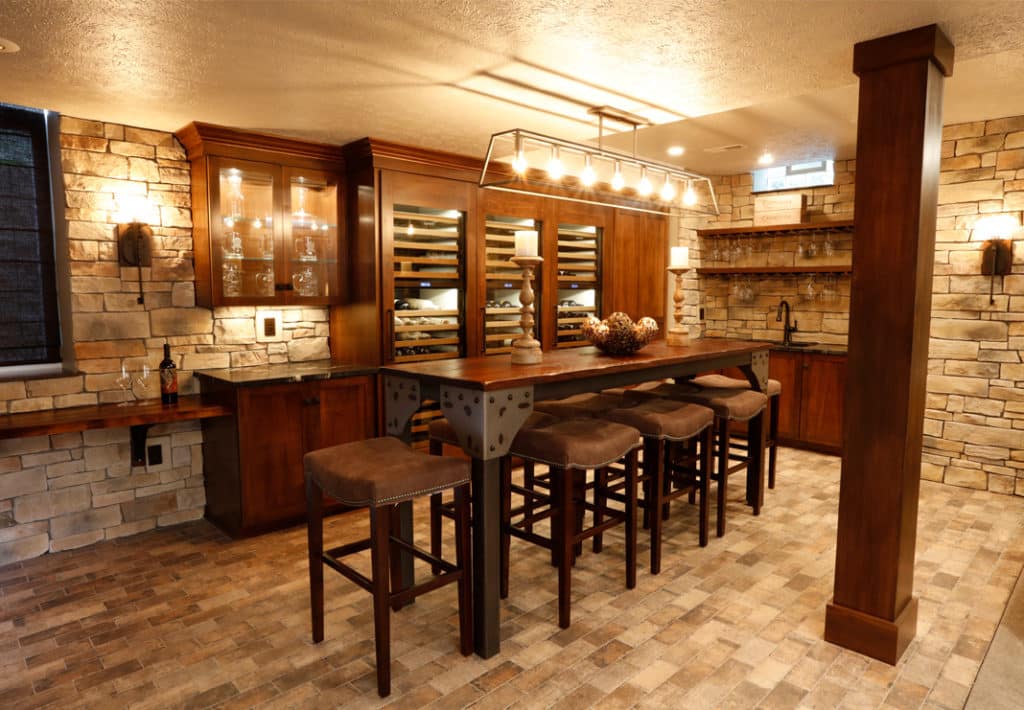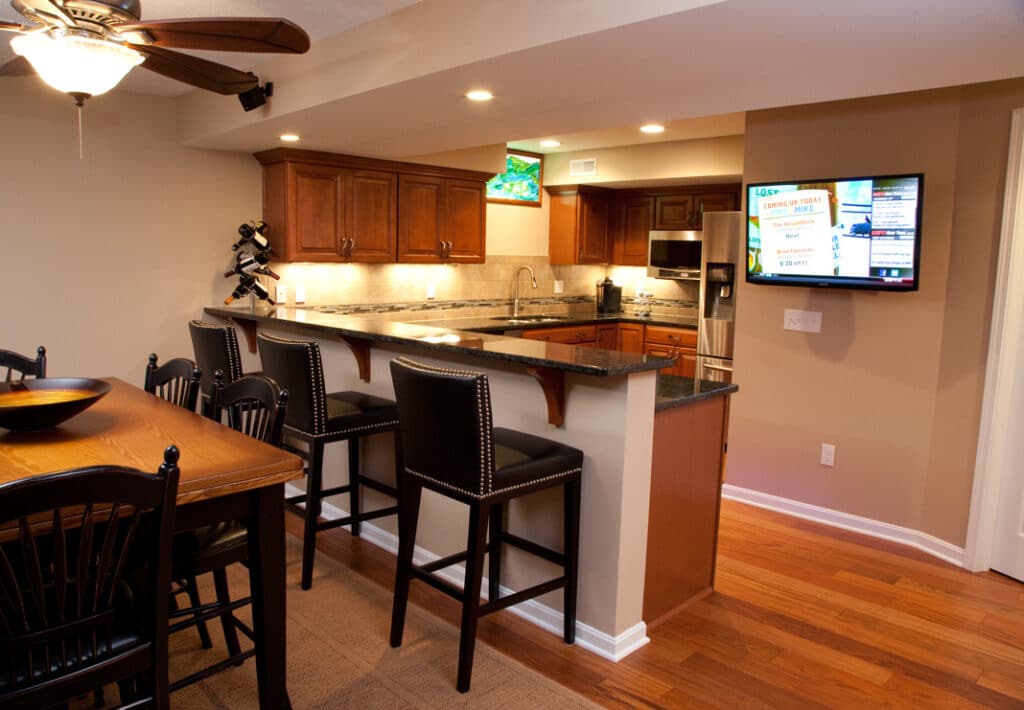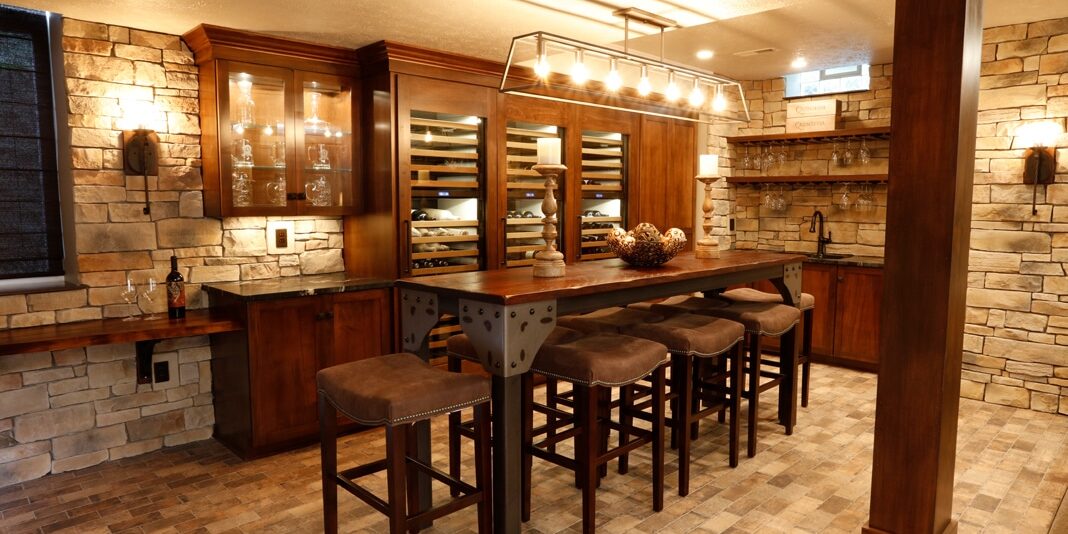What’s the best option for basement flooring?
Here’s what I tell customers…
Not all basements are created equal. The key to selecting the right flooring for your basement remodel is to first understand the unique conditions in your basement, and then plan accordingly.
Start by considering the age of your home. Most older homes built in the 1900s and ‘50s have cellars which were not intended to be used as livable space. Many of these basements have concrete floors that have a lot of roll to them with uneven surfaces. It’s important to evaluate, and level the concrete subfloor as needed, before laying down new flooring to ensure proper wear and performance.
Pay attention to the moisture and humidity levels. In addition to uneven floors, many older homes can have moisture problems in the basement. Is there a stale odor? Mold or mildew on surfaces? Do you see efflorescence on the grout line of the cinderblock foundation? These are signs that you might have water or high humidity levels present in your basement. Although moisture-related issues can be more common with older homes, they do exist in both old and new construction. It’s wise to look for these “water” warning signs and correct the source of the problem before you start your flooring project.
Carpet. With the understanding that the living area is dry and there are no outward signs of moisture, carpet can be a great option, adding comfort and warmth to any room. An elegant texture or pattern can dress up a highly refined “lower level,” while a more casual style carpet can help create a relaxed, comfortable feel to the living area. Being more forgiving of subfloors that are not flat and level, carpet in either setting, can be a great budget-friendly option for basement flooring. For optimum performance choose a durable carpet product right for the space. (If you choose to install the carpet with a pad, just be mindful that pads retain moisture, so if there is any worry about moisture in the space, opt for the no-pad install.)
A commercial grade carpet product, either traditional or carpet tile, can be a good option in certain circumstances. These products can be glued down with no pad, directly to the concrete floor. Carpet tiles with rubber backing can be glued directly to the concrete floor—and should you have an issue in an area of your basement where water enters, it’s easy to remove and replace only that section of tiles. It’s a less permeant carpet option that offers the same benefits of traditional carpeting in the basement: softer underfoot, and a warmer, quieter living space.
Ceramic tile is a great worry-free option for basement flooring when you’re installing over a level floor. A rigid porcelain tile product makes an impermeable bond with the concrete, will hold up against moisture and is the most durable flooring option. However, unlike carpet, tile can be less comfortable and cold underfoot.

Laminate & Vinyl. Although highly improved over recent years, most laminate flooring products have a 70% wood composition, so they will not perform well if water is present. If you have 100% dry conditions in your basement, it’s safe to go with a laminate. But, if you want a product that gives you high durability and less hassle, go with luxury vinyl tile or vinyl plank flooring.
Vinyl tile or plank flooring can be installed using either a glue-down or a floating application. These vinyl products are highly durable and 100% waterproof. A word of caution: if your basement has water issues, mildew can form underneath these flooring products.
PRO TIP: A major factor in helping maintain a dry basement is proper landscaping and grade. Be sure to keep water flowing away from the foundation of your home. Check gutters and downspouts to make sure they’re functioning; and regrade as needed to keep your basement dry.
Hardwood. Again, pay attention to moisture and humidity levels in your space. Hardwood planks contain a plywood core with a real wood veneer on the surface; they can be glued down directly to concrete. When our Dover technicians install a hardwood surface in a basement we always start with a relative humidity (RH) test. Drilling into the concrete, it tests the moisture level in the floor. If the humidity reading is within the range the manufacturer deems as acceptable for product performance, then we continue with our install. (After completing the RH test we record the data for later. In the event that the space needs to be retested, we have a base for comparison.)
As an added safeguard during installation, we use a high-end glue product that creates a moisture barrier between the wood and the concrete. Installed correctly, hardwood can be a comfortable option for basement flooring. It maintains the ambient temperature of the room, is softer underfoot than other hard surface options and adds value to the home.
Mix it up. Many of our basement flooring installations include multiple flooring products. Consider using carpet in the main living area or theatre room, and then go with more forgiving hard surfaces in a bar, kitchenette, game room, home gym or bathroom. Hard-surface waterproof flooring is also a smart option for walkout areas, where the elements like rain and snow are easily brought into the basement space.
Above all, the biggest concern about choosing the right flooring for your basement renovation is paying attention to moisture. And then, simply follow the same durability factors as you do when selecting flooring for the upper level of your home.
If you’re interested in learning more or discussing your basement flooring ideas, stop by the Dover Flooring & Tile Center. We’re here when you need us.
Tschaun Procaccini






